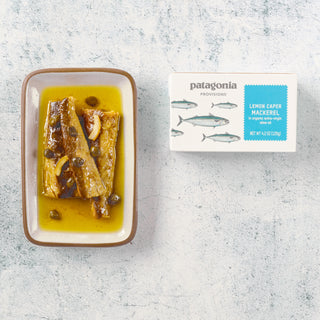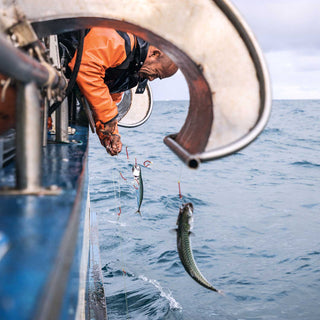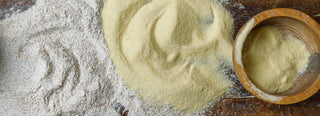Durum semolina (usually just called “semolina”) is widely recognized as an ideal flour for pasta, since its protein structure and coarse grind help pasta shapes stay firm during cooking and develop an appealing texture. But we’ve gone a step further: We add flour made from organic Kernza® perennial grain to our organic semolina. This allows us to produce pasta with richer flavor and more essential nutrients—while also helping revive damaged topsoil.
What Is Semolina?

Semolina is a type of flour ground from durum wheat, an especially nutritious annual variety that was domesticated about 9,000 years ago from emmer wheat strains. Durum wheat grows best in arid soils, like those found in the Middle East and along the Mediterranean. Durum means “hard” in Latin, so named because its grains have a particularly hard endosperm (the starchy part). The grains also have relatively high levels of the proteins glutenin and gliadin. When mixed with water, these proteins form springy gluten chains that give pasta (and bread) elasticity.
How is semolina made?
Durum grains are milled using steel rollers that flake off the bran and germ, leaving behind nuggets of carbohydrate-rich endosperm, which are then ground into a coarse flour called semolina. Semolina has an almost golden color, and it brings a delicious, earthy smell to the kitchen.

Is Semolina Pasta Healthy?
Semolina has among the highest protein levels of any pasta flour (around 13%, compared to 9-11%, on average, for all-purpose flour). Semolina includes B vitamins like folate and thiamine, as well as antioxidants.

What Is Kernza?
Kernza perennial grain is a type of wheatgrass developed by plant breeders at The Land Institute in Salina, Kansas. Conventional wheat, like all other conventional grain crops, is an annual, meaning it has to be replanted every year. Kernza is remarkable because it’s a perennial—it stays rooted in place for at least a few years.
Years of R&D have increased the plant’s seed size and yields, resulting in a grain that has the nuttiness of wild rice and the spiciness of rye, with a sweetness reminiscent of molasses. Below ground, Kernza is even more remarkable: Its roots can reach down as far as 12 feet (more than twice that of annual wheat), creating a massive, beard-like tangle. These mighty roots hold precious topsoil in place and help increase water absorption, so the land is less affected by drought and flooding. The roots also house billions of beneficial microbes that build soil health.

How Is Kernza Flour Made?
Like wheat grains that are processed for white flour, our organic Kernza grains are cleaned, dehulled, and milled to remove the inner germ and some of the outer bran, both of which oxidize quickly and shorten shelf life. The resulting pasta flour is a toasty beige color and smells wonderfully fresh, sweet and nutty.

Is Kernza Pasta Healthy?
Yes. Finished Kernza pasta contains more fiber than ordinary semolina pasta, contributing 10% of the average person’s ideal daily intake (vs 6% for the ordinary pasta). It’s low in fat (with no saturated or trans fats) and has no sodium or cholesterol.

Why Pair Semolina and Kernza
in Pasta?
Good pasta is delicious, nutritious and holds its shape during cooking. Semolina’s gluten proteins are structurally sturdier than those in Kernza, so we pair the flours to make sure our Kernza pasta retains its integrity as it boils. The resulting pasta—full of nutty, warm flavor and a pleasantly springy texture—tastes great with nothing more than salted butter or a drizzle of olive oil. That said, Kernza pasta works well in just about any plant- or meat- based recipe, including comforting pasta bakes and pasta salads.
Just as satisfying is knowing that every bowl of Kernza pasta supports a solution to climate change and vanishing topsoils.









